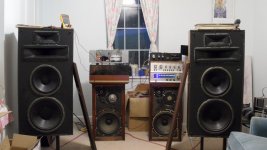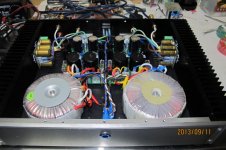Yes, for over three hours. The only thing that felt remotely warm was the heatsink on the diodes but only the slightest bit warm. I wasn't intending to use it as the power supply for the HB. I just had it handy and needed to test the amp. It sounded so good I hooked both channels up to it and let it play. I had the variac turned all the way up, which is about 130VAC so I was getting 47VDC out of the 25VAC torroid. It drooped lest than a volt when under a load. Pretty impressive.
If I where to use this multiplier with a couple of F6 amps,that requires +-23v 3 ampFor anyone else: For a power amp which has a very high standing current (or class A), the dropout voltage should not be set any higher than needed for ripple and noise suppression.
(bias supply)will the dropoutvoltage be 3v then?What voltage do the trafo have to be?
Will it be enough with the sinks on the pcb?
Not the heatsinks on the pcb, no. Those are the correct size for a class AB amp with much smaller bias/idle current. The pass transistor heatsink is rated at 11 C/watt. The slightly bigger 2-inch (50-mm) version at 9 C/watt. This is enough for VSSA or a similar class AB amp to about 100W, and with some small changes, up to about 150W. Not for Class A.If I where to use this multiplier with a couple of F6 amps,that requires +-23v 3 amp
(bias supply)will the dropoutvoltage be 3v then?What voltage do the trafo have to be?
Will it be enough with the sinks on the pcb?
There are a couple people who intend to do this, and just increase the heatsink sizes (one local friend of mine is going in this direction also). Basically, you plan on much more heat.
With respect, I do not think that is the best approach, but I am not 100% sure, because I have not tried yet. I do not like to waste so much power in the supply.
With 23V rail, 3V drop in the power supply, 15%, to me this is too much wasted power, and the cost of the supply goes up too much. If you compare to Class AB, 1~2V drop is only 3~4%, and the power supply is not so expensive.
I think I would start with the complete F6 supply requirements, transformer VA rating, voltage, idle current, peak current, and calculate component ratings from that. If you post what those numbers are, I can help you select the components.
The updated list of names for the second PCB order has been posted. If you requested boards, please make sure your name is on the list below. Thanks.
http://www.diyaudio.com/forums/grou...ultiplier-power-supply-pcb-9.html#post3627015
http://www.diyaudio.com/forums/grou...ultiplier-power-supply-pcb-9.html#post3627015
The F6 "is run on +-23v on the schema" ,the trafo I use now,with C-R-C Psu is 600VA.I think I would start with the complete F6 supply requirements, transformer VA rating, voltage, idle current, peak current, and calculate component ratings from that. If you post what those numbers are, I can help you select the components.
Idle current,is that bias current?That is 1,5A/channel.Peak current Is that
Ipeak is the peak current through Rs (usually 2*Ibias)?
I´m not toe sure this is the way to go either,that depends on the heat on the pass transistors,as I have allready built this amp,thinking I could use the alu bottom as a heatsink or mount a "small" 20x12 cm on the bottom.
So far we have seen PMI's masterpiece and one other completed project (albeit slathered in lead ;-)
So has anyone else got pics to share?
Here is 1 VSSA on PMI Masterpiece, Pushing those Speakerlab S7WA's with no Problem.Excellent Bass! 😀
Here is 1 VSSA on PMI Masterpiece, Pushing those Speakerlab S7WA's with no Problem.Excellent Bass! 😀

Well, mostly thanks to Mr Evil's clever ideas, which he gave me kind permission to copy for my various versions of VSSA and PeeCeeBee... 😀
(Very happy to see it working!)
Line and load regulation at work... 😀Yea, me to.! That Traffo 30VAC secondaries is giving me +/- 42.8 After 1v pass drop!😱
Take a transformer rated at 115V line voltage and 30V secondary voltage at full load, and at high-line voltage and low load, you might get 33V AC.
The Schottky diodes have a low forward voltage drop, and with Class AB, you do not need a big voltage drop across the pass transistor to get a clean supply...
( just enjoy the sound for a while before you play any test tones! 😉 )
( just enjoy the sound for a while before you play any test tones! 😉 )
Ya, i hear you. Did you ever give a listen.? i can shake this old house with the bottom end of that sweep, but make sure your Woofer Surrounds are in good shape.!

Capacitor multiplfier
Hi Ranchu, I got it from eBay. The case was reasonably cheap the shipping was a bit expensive.
Quan
Hi Ranchu, I got it from eBay. The case was reasonably cheap the shipping was a bit expensive.
Quan
What size transformers and supply voltage are you using?My VSSA up and running with 2+ CM . Sound beautiful. No soft start needed. Yeah.
I ask mainly because I've had a couple questions about soft start, and in reference to what I have posted about the gradual ramp up of the supply voltage (which was one of my goals for this supply).
In my case at least, the slow startup essentially eliminates any turn-on noises, thumps, etc. However, I typically use smaller transformers than most people, and I am on 120V AC mains... so, I can't really present evidence for a 100% convincing argument. If you (or anyone else) would comment, I think it might help convince some other people, especially those with 220VAC mains voltage.
Thanks.
ZVN2106A, substitutes
The ZVN2106A is out of stock and on backorder at Mouser, but it is available from Newark (and on sale there).
Closest alternative for the ZVN2106A/ZVP2106A Mosfets I have found from the same manufacturer, and stocked at Mouser is this pair:
ZVN3306A / ZVP3306A
Other suggestions and comments are welcome.
The ZVN2106A is out of stock and on backorder at Mouser, but it is available from Newark (and on sale there).
Closest alternative for the ZVN2106A/ZVP2106A Mosfets I have found from the same manufacturer, and stocked at Mouser is this pair:
ZVN3306A / ZVP3306A
Other suggestions and comments are welcome.
Hi Peter, I am using two 300VA transformers with dual 30V secondaries.What size transformers and supply voltage are you using?
I ask mainly because I've had a couple questions about soft start, and in reference to what I have posted about the gradual ramp up of the supply voltage (which was one of my goals for this supply).
In my case at least, the slow startup essentially eliminates any turn-on noises, thumps, etc. However, I typically use smaller transformers than most people, and I am on 120V AC mains... so, I can't really present evidence for a 100% convincing argument. If you (or anyone else) would comment, I think it might help convince some other people, especially those with 220VAC mains voltage.
Thanks.
Quan
It may be useful to re-read Mr. Evil's circuit description on his website (see post #1 in this thread)
Other suitable Nchannel types, in TO92 package with DGS pinout, include
There is no need to match the Nchannel differential pair to the Pchannel diff pair; they operate completely independently. One is in the positive capmul and the other is in the negative. The two capmuls operate independently.
As long as the two Nchannels have approximately the same Vth and gm as each other, and also the two Pchannels have approximately the same Vth and gm as each other, there is no reason to expect or hope that the Nchannels resemble the Pchannels, at all. You have complete freedom to purchase Vishay Pchannels from Herkimer Llewellyn, and to buy Fairchild Nchannels from Oswald Cobblepott, if those devices happen to be in stock on the day you order.
Differential stage MOSFETs are ZVN2106A and ZVP2106A. The exact type is not critical here and they don't need to be specially matched. The only benefit to matching them is reduced DC offset, which is of course meaningless for a DC power supply.
Other suitable Nchannel types, in TO92 package with DGS pinout, include
- 2N7000 (41684 in stock at DigiKey)
- BS107 (13240 in stock)
- ZVNL110 (11450 in stock)
- FQN1N50 (8804 in stock)
- BS170 (7092 in stock)
There is no need to match the Nchannel differential pair to the Pchannel diff pair; they operate completely independently. One is in the positive capmul and the other is in the negative. The two capmuls operate independently.
As long as the two Nchannels have approximately the same Vth and gm as each other, and also the two Pchannels have approximately the same Vth and gm as each other, there is no reason to expect or hope that the Nchannels resemble the Pchannels, at all. You have complete freedom to purchase Vishay Pchannels from Herkimer Llewellyn, and to buy Fairchild Nchannels from Oswald Cobblepott, if those devices happen to be in stock on the day you order.
I used the Zetex MOSFETs because I already used them for the amplifier that I built at the same time. Otherwise there is nothing special about them. Any small-signal MOSFETs should give reasonable performance.
What size are your mains fuses to the two transformers? What power would those fuses (if fitted) pass continuously and forever?No soft start needed.
- Status
- Not open for further replies.
- Home
- Amplifiers
- Power Supplies
- Finished capacitance multiplier

